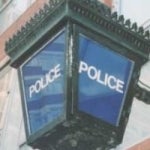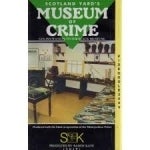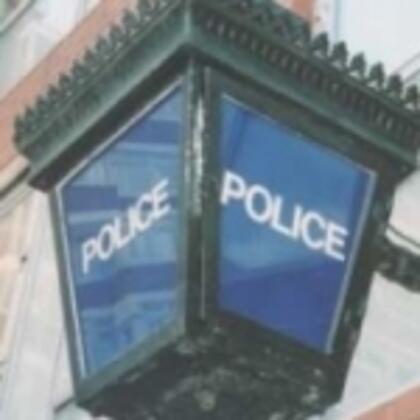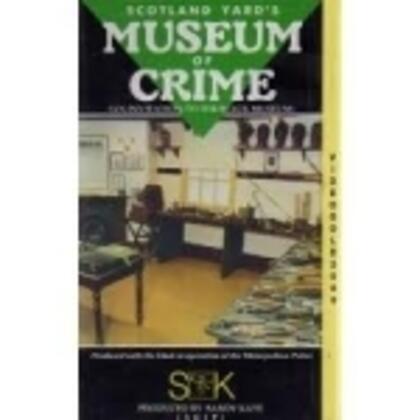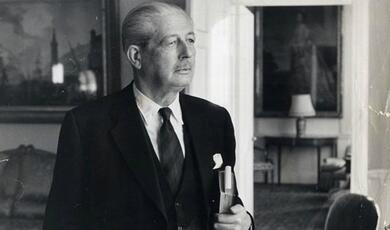Faces in Court 1893-1918: Drawings of William Hartley from New Scotland Yard's Crime Museum
Share
- Details
- Text
- Audio
- Downloads
- Extra Reading
William Hartley (1862-1937) was an early Fleet Street photographer whose fame was achieved from his court room sketches from the Old Bailey, Bow Street and other famous courts. Six volumes of his original sketches were donated to the world famous Crime Museum at New Scotland Yard, covering the period from 1893 to 1918, when many classic murder cases took place including Dr Crippen.
This is the sixth in a series on Special Collections. The other lectures in this series are on the following collections:
Anatomy Museums
The Guildhall Library
British Architectural Library, RIBA
The Library and Archives of the Society of Friends
Lambeth Palace
The Royal Horticultural Society's Lindley Library
St. Paul's Cathedral
Download Text
It is only in recent years that attention has been drawn to the six volumes of original William Hartley court sketches believed to have been donated by the artist at some point during the early twentieth century. Some of the drawings made it into the contemporary newspapers like The Morning Leader and The Star. Others, however, have remained unpublished and unseen. William Hartley himself was born in 1862 and was an early Fleet Street photographer, but his fame was achieved not with his camera, but from court room sketches from the Old Bailey, Bow Street and other famous courts. Because photography in the court precincts was illegal, Hartley had to resort to his drawing skills to provide newspaper readers with images of the people taking centre stage in the dramatic trials for murder and other crimes that enthralled the nation. He soon became renowned for the speed, accuracy and the quality of his drawings. He became a famous exponent of what soon became an art form in its own right. Sometimes the drawings seem to convey the character and dilemmas in the mind of the person in the dock. Hartley actually started his career as a stained glass artist before moving to London. He covered many of the famous criminal cases in the late nineteenth century until the end of the First World War. William Hartley died in 1937 at the age of 75. Selected Cases Chicago May and ‘John Smith’ 1907 May Duignan came from a poor Irish family but stole her family’s savings to pay for a first class cabin on a ship to America where she settled in Chicago around 1890. She embraced the Chicago vice scene with some enthusiasm, but later graduated to fraud, travelling to Paris and London. She met up with Eddie Guerin who had been taken as a boy to Chicago by his Irish parents and later became notorious for various criminal enterprises including escaping from a number of prisons. They went to Paris together. Guerin and two accomplices robbed the safe of the American Express office. Chicago May demanded her share of the loot, and carried most of Eddie’s share on the train back to London, from which he was arrested, but she was not. Eddie Guerin was later convicted and transported to life to a French penal colony off French Guiana, near to ‘Devil’s Island’. He escaped, made his way back to England via America and Canada and found Chicago May again, much to her surprise, particularly as the money had been long since spent. They fell out. May informed the police of the whereabouts of this fugitive from French justice and Guerin spent many months in Brixton prison fighting against extradition. His legal battle was successful and he was released, but no sooner had he celebrated his new-found freedom than he was victim of a shooting in Bloomsbury. Chicago May and ‘John Smith’ were arrested at the scene and, probably for the first time in his life, Eddie Guerin went to court as the victim of a crime. Dr Crippen 1910 Dr Hawley Harvey Crippen was an American doctor who worked for a patent medicine company. His first wife died in about 1890 and he then linked up with a 19-year-old Cora Turner, alias Mackamotzki and married her. They came to England and Cora, who used the stage name Belle Elmore, was an unsuccessful music hall singer. In January 1910, Cora disappeared, and Ethel le Neve, Crippen’s secretary, moved in to Crippen’s house in Hilldrop Crescent, Holloway. Cora’s stage friends became suspicious and went to Scotland Yard where Detective Chief Inspector Walter Dew took up enquiries, interviewed Crippen and then left it until after a weekend of checking Crippen’s story before returning to Hilldrop Crescent to find that Crippen and Le Neve had disappeared. The police found human flesh under the coal cellar floor, but no head or limbs. A young Bernard Spilsbury took a prominent part in the case, which was a wonderful story for the newspapers. Walter Dew and Scotland Yard had to decide whether to trust the suspicions of Captain Kendall whose ship ss Montrose was equipped with the new Marconi ship-to-shore telegraph system. Dew took a faster ship from Liverpool and arrested Crippen and Le Neve as they arrived off Canada. Mrs Pankhurst 1912 It was the time of the Suffragettes. William Hartley recorded the expressions of calm and defiant resistance displayed from the dock by Emmeline Pankhurst and her co-defendants Mabel Tuke, and Frederick and Emmeline Pethick-Lawrence. They had been involved in throwing stones at the windows of 10 Downing Street on 1 March 1912. Emmeline Pethick, a social worker, joined the Women's Social and Political Union (WSPU), an organisation that did not allow men to become members. She, and Frederick Lawrence, who worked in London’s East End, had fallen in love, but Emmeline would not marry Frederick because he did not share her socialist beliefs. Nevertheless, Frederick used his legal training to represent the WSPU in court when he was not a defendant himself. He became the Labour MP for Leicester in 1923, defeating Winston Churchill in that year’s General Election. Mabel Tuke, also known as Pansy, was joint general secretary of the WSPU. Whitaker Wright 1904 Whitaker Wright (1846 – 1904) was the son of a Methodist minister who was a lay preacher himself at one point. He went to Canada and made a lot of money through mining, and then returned to England and formed the London and Globe Company. He issued investments and called some of them ‘consols’ a term used for state bonds that were solid and reliable investments. He invited aristocrats on to the boards of the companies in which he was involved. In 1900 he backed the construction of the Baker Street and Waterloo railway, but the investment collapsed. He tried to cover his insolvency by making a series of loans from one company to another, but his empire collapsed and caused panic on the Stock Exchange. He was prosecuted by stockholders who instructed the barrister Rufus Isaacs who had previously worked as a stockbroker. The trial judge was Mr Justice Bigham who was a corporate law expert. Wright was convicted and given seven years, but committed suicide with a cyanide pill in a side room of the court. He also had a revolver in his pocket, court security being somewhat different in those days. Hooley and Lawson 1904 Once one of the richest men in England, Ernest Terah Hooley was a property developer and stockbroker who developed an industrial estate at Trafford Park in Manchester. He later moved his business down to London and adopted a lavish lifestyle. He was adopted as a Conservative Party parliamentary candidate for Ilkeston in Derbyshire in 1897 but then got into financial difficulties and was made bankrupt the following year. In 1904 he was acquitted of fraud, but Lawson, pictured with him, was convicted. Hooley spent six months in Brixton for contempt of court in 1911 and then got 12 months for false pretences in connection with a land deal. A German spy case Some drawings are of cases that we have not yet identified. One of the images may be connected with a Special Branch operation that originated in a surveillance operation in May 1910 on one of the Kaiser’s entourage during a visit to England for the funeral of King Edward VII. Captain von Rebeur- Paschwitz slipped out of the back entrance of his hotel and took a cab to a barber’s shop in Caledonian Road where a German by the name of Karl Gustav Ernst acted as a post office for a number of German spy networks. By the time that the war did break out, letters to and from the barber had been discreetly copied, and numerous arrests followed. Charles and Martha Stephenson 1904 William Warner, known as Cheiro, was an Irish astrologer who became famous for reading palms in fashionable high society, and kept a Visitor’s Book where his famous clients would leave their comments. Foretelling the future became one of the activities of the age, but it also spawned a number of cases where people could give vent to their exotic creative powers to pose as fortune tellers, some of which resulted in prosecutions for fraud. Adolf Beck Adolf Beck was a Norwegian businessman who was the victim of a spectacular miscarriage of justice. He was imprisoned in 1896 on identification and handwriting evidence for a series of frauds on which a number of women were tricked into lending their jewellery to an apparently aristocratic gentleman who gave them a cheque to buy clothes so that he could take them on a cruise. There had been a run of similar frauds committed by ‘John Smith’, whose real name was William Weiss, in 1877. Beck served his sentence and was arrested again in 1904 for a fresh series of the same unusual kind of fraud. The police officer who arrested Weiss in 1877 gave evidence that Beck was the same man. Prosecuting counsel in the 1877 case acted, by coincidence, as the trial judge in the 1896 case. It was only the lingering doubts of the 1904 trial judge, Mr Justice Grantham, after Beck’s second conviction, that caused Beck to be remanded in custody to await sentencing. Whilst he was awaiting his sentence, a fraud of the same type occurred whilst Beck was in prison. Two sisters, Violet and Beulah Turner, had asked their landlord to follow the supposed lord who had invited them to go cruising with them. The lord went to a pawnbroker to dispose of the sisters’ rings. The landlord called the police who arrested the man, who turned out to be none other than the original man Weiss, now using an alias of William Thomas. Adolf Beck was granted a free pardon, awarded £5,000 in compensation, and was the catalyst for the introduction of the Court of Criminal Appeal. Horatio Bottomley Horatio Bottomley was the Liberal MP for Hackney South who produced the John Bull a patriotic journal. He started the John Bull Victory Bond Club, a forerunner of premium bonds, and had a great talent in persuading people to spend their money on the bonds. A mixture of fraud and mismanagement resulted in the collapse of the scheme, his conviction for fraud, a sentence of seven years imprisonment, and his expulsion from Parliament. The Murder of William Terriss, December 1897 In 1897, William Terriss, a famous actor manager in London's theatre land was stabbed to death in Maiden Lane outside his own theatre by an unsuccessful Scottish actor, Richard Prince. Terriss had taken pity on Prince's situation, had given him recommendations to find him work and had lent him money, only to find his kindness repaid with a violent and fatal attack. Prince was tried at the Old Bailey in January 1898, found guilty but not responsible for his actions. He was committed to the criminal lunatic asylum at Broadmoor. The murder weapon is on display in the museum. The Peasenhall Murder of 1902 Early one morning in 1902, after a particularly violent thunderstorm the previous night, William Harsent came to visit his daughter Rose in the sleepy village of Peasenhall in Suffolk. He discovered a shocking scene. His daughter lay, almost naked, in the kitchen. A pool of blood spread beneath her head and neck and her nightgown was burnt. Broken glass and spilt paraffin lay all around. Her throat had been cut. Twenty-three years old, unmarried and pregnant, Rose seemed to have committed suicide. But bruising on her right cheek, the discovery of an unsigned assignation note and the absence of any instrument or weapon swiftly pointed to murder. The girl's violent death was an event which rocked the fabric of the close village life in Peasenhall – and no less shocking was the implication of William Gardiner, a married Methodist worthy with whose name Rose had been previously scandalously linked. Gardiner found himself on trial for his life twice over, and was neither convicted nor cleared. When he fled into obscurity he left a small community still in shock and an unsolved case which has remained one of the classics of the twentieth century. George Chapman @ Severin Klosowski, 1903 Chapman was the son of a Polish carpenter and came to England in 1888, working as a barber's assistant in London's East End. He married in 1889 and went to America. By 1895 he had parted from his wife, and on returning to England lived with a married woman, Isabella Spink, using her money to set up as landlord of a public house in City Road. After a few months, Mrs Spink became ill with vomiting and abdominal pains. She died in 1897. The following year Chapman employed a young woman, Bessie Taylor, as barmaid. She too became ill and died in February 1901. The doctors were puzzled but not suspicious. In August 1901, he hired Maud Marsh as a barmaid, passing her off as his wife. Like her predecessors, she developed abdominal pains, became ill and died in October 1902. Now strongly suspecting poisoning the doctor refused to grant a death certificate and Miss Marsh was found to have died of antimony poisoning, as were the other two women when their bodies were exhumed. Chapman was charged with the murder of Maud Marsh, found guilty at his trial at the Old Bailey and hanged in 1903. Chapman's name is often linked Jack the Ripper although there is no known historical evidence that he was investigated by the police or came under suspicion at the time of the murders in 1888. The Moat Farm Murder 1903 When a rich spinster, (Camille Holland), fell for the charms of Samuel Herbert Dougal, a virile ex-soldier, his fortunes took a turn for the better. In 1899 they moved into a lonely farmhouse near Saffron Waldon which Dougal named Moat Farm. Dougal, however, soon found that Miss Holland was not as carefree with her money as with her affections, and after having been caught trying to seduce the maid, he was ordered to get out of the house. Shortly after this, Camille Holland disappeared and Dougal scandalised the neighbourhood by entertaining a succession of women at Moat Farm. For four years Camille's disappearance remained a mystery, but the police, dissatisfied with Dougal's explanations, began to delve into his bank transactions. They quickly learned that he had been forging Camille's signature on cheques long after she had disappeared. Dougal promptly went to ground, but was identified in London and detained for questioning. In March 1903, he was arrested for forgery. A thorough search of Moat Farm led to the discovery of Camille's body in an old drainage ditch. She had been shot in the head. Dougal was tried at Chelmsford Assizes in June 1903, sentenced to death and executed on July 14th 1903, having confessed his guilt to the chaplain on the scaffold. Stratton Brothers 1905 On the morning of March 27th 1905, the dead body of an elderly man, (Thomas Farrow), was discovered at his shop in Deptford. His head had been savagely battered in. Upstairs, his wife lay unconscious in one of the bedrooms. She died of her injuries four days later. A cash-box had been forced open and its metal tray bore the mark of a right thumb-print. Fingerprint technique was in its early stages in Britain, but even though this thumb-print matched none of the people at the crime scene nor any of the 85,000 sets of prints then on file at Scotland Yard, it was still regarded as a vital clue. Local gossip had it that two brothers might have committed the crime and suspicion centred on two young men, Albert Stratton (aged 20), and Alfred Stratton, (aged 22), both of whom had records for burglary and house breaking. The brothers were arrested and their fingerprints taken. Alfred's right thumb-print was a perfect match with that on the cash box. Both brothers were tried at the Old Bailey in May 1905, found guilty and hanged together a few weeks later, each blaming the other for committing the murder. Their trial was unique and represented a landmark in criminal history as it was the first time in a British court that finger-print evidence was used to obtain a conviction for murder. Siege of Sidney Street 1911 In December 1910, a gang of Latvian immigrant burglars tried to burgle a jeweller’s premises in Houndsditch. Police attended the scene and three City of London policemen were shot dead. Some of the Anarchists were arrested but some escaped into the Metropolitan Police District of Stepney. On 2nd January 1911, police were informed that two of the gang were sheltering in a flat on the second floor of 100 Sidney Street. A combined force of Metropolitan and City of London Police cordoned off the area and evacuated residents. A policeman was shot and wounded, gunfire was exchanged by both sides, but the police weapons proved completely inadequate for flushing out the gunmen whose Mauser automatic pistols were capable of rapid and deadly fire. Volunteer marksmen of the Scots Guards arrived from the Tower of London, as did the young Home Secretary - Winston Churchill - who decided that heavier artillery was required. The house eventually caught fire and the two gang members burnt to death. The failure of the police marksmen and their equipment was duly noted and improved firearms were ordered with better training for officers. This was a very rare case, and probably the last, of a Home Secretary taking police operational command decisions. Attempted Assassination of Sir Edward Henry, 1912 On November 27th 1912, the Commissioner of Police, (Sir Edward Henry),was shot at three times and wounded as he opened the front door to his Kensington home. His assailant, 25-year-old Albert George Bowes, had been refused a licence to drive a 'mechanical stage carriage' as a result of a conviction he had received for being drunk and disorderly eight months previously. Bowes had become fixated with the idea that Sir Edward had personally been responsible for his application being refused . At his trial at the Old Bailey in January 1913, Bowes pleaded guilty to attempted murder. Sir Edward, still suffering from his leg wound, appeared at court and in keeping with his humanitarian spirit, made a personal plea for leniency on Bowes’ behalf, as a result of which Bowes had his life sentence reduced to 15 years’ penal servitude. Sir Edward maintained an interest in his fate and paid for his passage to Canada for a fresh start when Bowes was eventually released from prison in 1922. The Trial of the Seddons, 1912 40-year-old Frederick Henry Seddon lived with his wife, their five children and his aged father at 63, Tollington Park, Islington. In July 1910 the Seddons took in as a lodger 49-year-old Miss Eliza Barrow, a wealthy spinster. During the next few months, Seddon acquired all Miss Barrow's financial assets, which she exchanged for an annuity, amounting to £3 a week. In September 1911, Miss Barrow became ill with vomiting and diarrhoea. A doctor was called but she died a fortnight later. None of Miss Barrow's relatives were informed about her death and a cousin only learned about it when he called on the Seddons - by which time Miss Barrow had been buried cheaply in a common grave at Islington Cemetery. The cousin became very suspicious of Seddon's evasive answers when he enquired about Miss Barrow's various properties and investments and even more so when he was assured by Seddon that everything had been properly made over to him. The authorities were notified and Miss Barrow's body was exhumed, to reveal that she had been poisoned with arsenic. The Seddons were tried at the Old Bailey in March 1912 and the jury found Seddon guilty but his wife was acquitted. Seddon was hanged at Pentonville on April 18th 1912. William Hartley was there, as ever, to record their appearance in the dock, but the Crime Museum also has another reference to Seddon. He is the most infamous man ever to have actually visited the Crime Museum, and signed its Visitor Book! © Keith Skinner and Alan Moss 2013
This event was on Wed, 24 Apr 2013
Support Gresham
Gresham College has offered an outstanding education to the public free of charge for over 400 years. Today, Gresham College plays an important role in fostering a love of learning and a greater understanding of ourselves and the world around us. Your donation will help to widen our reach and to broaden our audience, allowing more people to benefit from a high-quality education from some of the brightest minds.


 Login
Login
